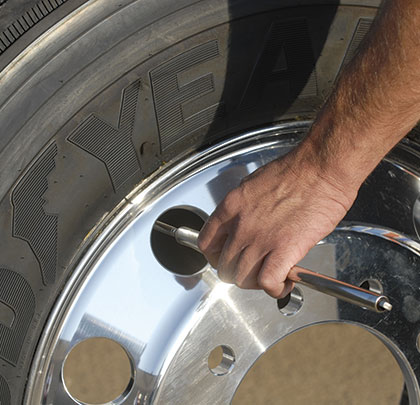Contractors who are looking for a sure-fire way to optimize the return on their commercial truck tire investment should start with inflation.
Quite simply, maintaining correct inflation pressure is the single most important tire care practice that a contractor can employ.
“Consistent, correct inflation positively impacts tire wear, casing life, and your tire’s overall performance,” says Brian Buckham, general manager, product marketing, Goodyear. “It can help reduce the amount of fuel your truck uses and even contribute to a more comfortable ride.”
CHECKING PRESSURE LEVELS
The benefits of checking—and if needed, adjusting—your tires’ air pressure levels more than compensate for the time and effort that this practice requires, according to Buckham.
“Both over-inflation and under-inflation change a tire’s footprint,” he says.
Over-inflation can result in a number of issues ranging from a harsher ride to irregular/fast treadwear.
Under-inflation causes tires to flex more as they roll, which generates excessive heat.
“These things cause tire component integrity to deteriorate if left unchecked,” says Buckham. “Under-inflation also can lead to irregular and uneven wear.”
In addition, under-inflation hurts a truck’s fuel economy, due to the simple fact that under-inflated tires force a vehicle’s engine to work harder.
“Tires are engineered to run at specific pressure levels based on the load they’re carrying,” says Buckham. “To determine the correct inflation level for your tires, gather information about your axle loads, and then refer to load charts like the kind you will find at www.goodyeartrucktires.com.”

OTHER FACTORS PLAY A ROLE
Truck operating speed also plays a role in the setting of optimal tire pressure. The tire industry has guidelines for allowing increased maximum loads if vehicle speeds are reduced. (“Think of large cranes that need to carry heavy loads but move slowly,” notes Buckham.)
Also keep in mind that ambient temperature has an effect on inflation levels. “Tire inflation pressure drops approximately one pound for every 10-degree decrease in ambient temperature,” he says.
Drivers should check inflation pressures at least once a week with a calibrated tire gauge or a gauge that is checked periodically, according to tire industry recommendations.
“Maintaining a record of tire inflation—plus tire inflation checks and adjustments—can prove beneficial, as well. Goodyear’s powerful Tire Trac tool, which is part of Goodyear’s Total Solution for fleets, can help you track this metric.
“Truck tires represent a significant capital outlay, and like any investment, should yield a profitable return. Frequent air pressure checks and adjustments will help you achieve this.” ■
For More Information: For more information about Goodyear’s Total Solution for fleets or any of its products, visit www.goodyeartrucktires.com.
_________________________________________________________________________
Modern Contractor Solutions – June 2016
Did you enjoy this article?
Subscribe to the FREE Digital Edition of Modern Contractor Solutions magazine.

Optimizing Your Truck Tire ROI


